Do you love the look and idea of stitching with fine silk threads, but are intimidated by working with them? Are you frustrated when you work with certain silk threads and wonder why the heck anyone would stitch with the stuff?
Today, I want to chat about silk embroidery thread, and specifically about filament silk embroidery threads, and even more specifically about Soie de Paris. Hopefully, through a discussion about these silk embroidery threads, we can allay frustrations and overcome Silk Thread Fear.
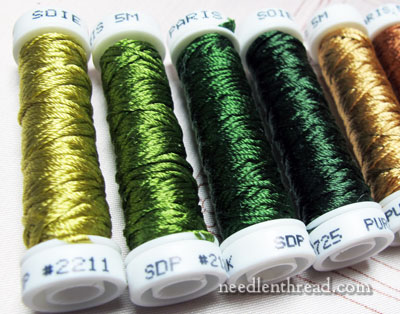
Soie de Paris is a filament silk. It’s important to know this, because, as a filament silk, it is not going to handle the same way that other threads and even other silk threads – specifically, spun silks – handle.
The Difference between Spun Silk & Filament Silk
Filament silk is reeled right off the silk cocoon, in very long, fine strands of very strong silk. Spun silk is made from silk cocoon leftovers and is spun much like other natural threads (cotton, wool).
Spun silk (Au Ver a Soie’s Soie d’Alger, Caron Waterlilies, Needlepoint Inc., Belle Soie , Rainbow Gallery’s Splendor, Kreinik’s Silk Mori, most of the “over-dyed” stranded silks on the market, and so forth) handle a lot like regular stranded cotton. They have a higher sheen than cotton – a beautiful, soft, glowing sheen – and it is a natural sheen, not chemically induced through mercerization. Good spun silk threads are soft threads that cover well and, depending on the brand, are usually quite beautiful and pleasant to stitch with. (Quality varies between brands!)
Filament silk (Au Ver a Soie’s Soie de Paris, Soie Perlee, Soie Ovale, Soie Gobelins, Soie 100/3; Trebizond; Japanese silk; Pearsall’s Gossamer silk; Piper’s embroidery silk; Chinese silks and others) have a very high sheen. They are also very strong. They are often more finicky to work with because they tend to snag on rough fingers (or anything else they can find to snag on), and they also have a certain “boing” to them – a kind of propensity to curl a bit, a predisposition towards static, and so forth. They need to be controlled.
If you’ve taken up stitching with Soie de Paris (or really any filament silk), once you understand that there is a difference between filament silk and most other threads you’ve stitched with, then you know that you have to treat the silk a little differently. You can’t treat it the same way you treat cotton floss, wool, or even spun silk.
So let’s look at some ways to treat filament silk differently, to improve the overall stitching experience.
Organization of Threads
The first consideration in treating filament silk differently is organization. By organization, I mean the way you organize yourself and your supplies while stitching.
When stitching with cotton floss, especially if sitting in an armchair or on a sofa, it’s pretty easy to drape the thread over the arms of the chair or the sofa. The threads may overlap, they might get stacked on each other, and they might even end up in a bit of a discombobulated mess. But it’s pretty easy to straighten out cotton floss in situations like this.
It’s also easy to fix pre-cut cotton floss or wool thread or spun silk on various types of thread organizers, like these thread drops, or homemade thread cards.
With filament silk, the above situations aren’t really an option. The silk will cling to furniture, it will tangle easily, and untangling it – especially with hands that are even slightly rough – can be a real pill.
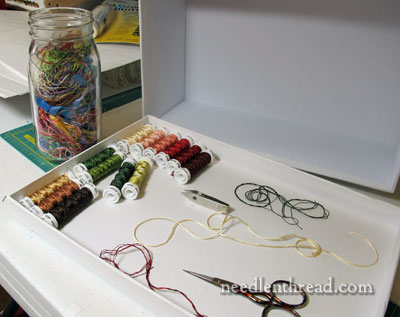
Enter the work tray.
Or, in my case, the box lid. I use box lids for work trays. In the tray, I keep the things I’m using on the project that I’m stitching, including thread, scissors, needles, and for the Mission Rose project, a pair of tweezers!
Next to my work tray, I have an orts jar. Orts are the little leftover bits of thread. Getting into the habit of putting these bits into a pre-determined receptacle (rather than dropping thread cuttings onto the work tray where they can get tangled up with usable threads) will go a long way to keeping the work space organized and embroidery threads under control.
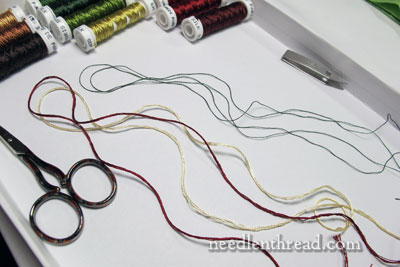
Soie de Paris is put up on spools. And I am ever-so-grateful for the fact! All the spools I’m using are in the tray.
Any threads that have been cut from the spool but haven’t been used yet are laid out neatly in the tray. While I’m working on this one project, I will keep all my cut threads lying in this tray, so that I can use them up without cutting new thread from the spools. As long as they aren’t heaped together in a bunch – as long as I straighten out the strand after separating a single thread from it – and as long as the tray is kept neat, the threads will be easy to access and they won’t get tangled.
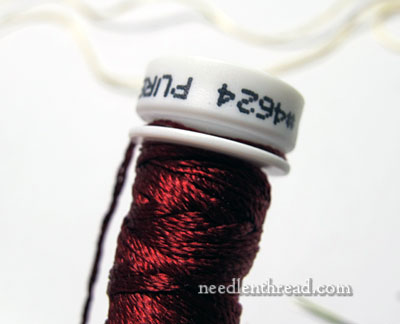
If, however, I want to put loose, cut threads away again, I use the spool to hold them. Each end of the spool has a little base that separates slightly from the rest of the spool, opening up a small space where the end of the thread can be wrapped…
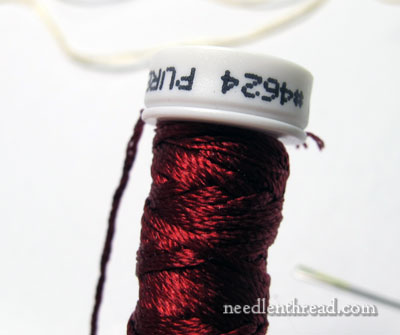
…and then the base is snapped closed to hold the thread.
I wind the excess around the spool…
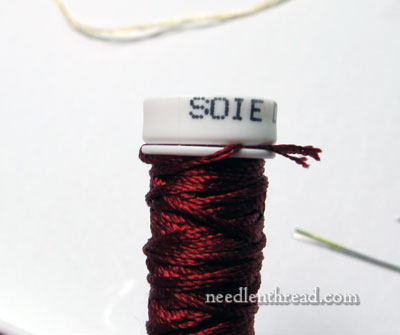
…and then insert the end of the excess thread into the space on the opposite end of the spool and snap the end closed. This holds my excess thread without having to put it into a plastic bag, where it could get tangled or where it will often contract a case of Static Cling.
The spool, then, is handy for organizing left over cut thread. You’ll never have to guess the color number of the thread, you’ll have a better idea of exactly how much thread you still have, and the thread itself won’t become tangled in a bag or staticky.
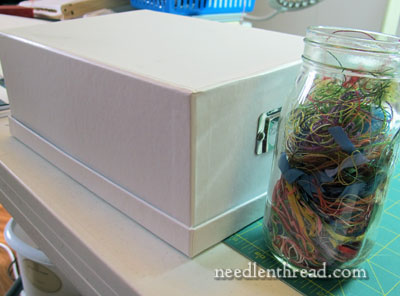
Keeping the work tray clean and dust-free between stitching sessions is also a consideration. I like to cover my work tray, and when I’m using a box lid, the easiest cover is the rest of the box, upside-down on top of the tray. It works perfectly. My supplies remain neat and clean and undisturbed until the next session.
You can adapt these methods of thread organization to any filament silks, especially ones that come on spools (Soie de Paris, Japanese silk, Pearsall’s, Pipers silk, etc.). But silks that come in skeins or hanks (Chinese silks, for example) require a little more care. It’s helpful to tie a thread around one end of the loop of the silk hank, to keep it from falling apart into a heap.
Stitching Techniques
Besides keeping the threads neat and organized, filament silk may require a slightly different stitching technique.
When using filament silk, my stitching technique changes slightly. After stitching for a while and thinking about it, I’m going to try to describe how I stitch when using filament silks.
I’m sure most stitchers have their own stitching mannerisms, and if you already have a method that works, then don’t worry about this! But I do encourage you to be aware of the way you stitch while using filament silks and try making little adjustments that will help the silk behave the way you want it to.
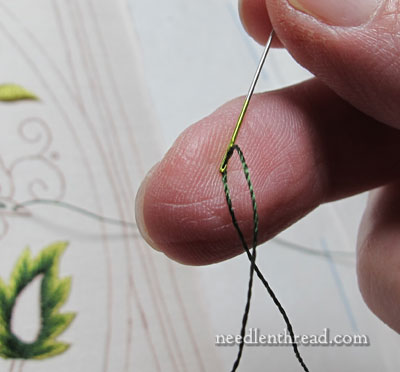
One thing I definitely do differently when stitching with filament silk is this: when I pull the needle through on the back of the fabric, I grip just the needle between my forefinger and thumb, and I touch the eye of the needle with my middle finger as soon as it comes through the fabric.
That little touch at the eye of the needle just as the needle passes through the fabric keeps the thread in the eye of the needle. I don’t hold onto the thread at all, except right at the eye, where it rests against my middle finger.
When I put the needle into the fabric from the front to take a stitch, I hold the needle right at the eye, between my forefinger and thumb, and stick it into the fabric at a 90-degree angle to the fabric (straight in). The eye of the needle is between my finger and thumb, and the needle sticks out straight in front of my finger and thumb.
This method of holding the needle works for me. My fingers barely come in contact with the silk, except a tiny bit right at the very eye of the needle. This minimizes the silk’s snagging on any rough spots, and it keeps the stitches flowing smoothly.
Speed of Stitching
Consider, too, your speed of stitching. While you may be used to flying along when working with cotton or wool, if you’re experiencing frustration with filament silk, try slowing down a bit, at least until you get a really good feel for how the thread works.
Your Needle Matters! & Other Tools
The size of the needle is another consideration when using filament silk. With Soie de Paris, you might be tempted to think that, since it is a relatively fine thread, you should use the tiniest needle in your collection.
On the contrary! While Soie de Paris will fit in a #10 crewel needle, it works much better with a #9 or even a #8. If your needle is too small, the fabric won’t open up enough to take the thread comfortably, making it much more difficult to pull the thread through smoothly. And when the thread doesn’t pull through smoothly, knots happen. And in removing knots, we come into more contact with the thread, increasing the risk of snagging.
So, if you’re having trouble working with Soie de Paris or another filament silk floss, try a slightly larger needle. It might make all the difference!
And if the thread slips out of the eye too easily, see the above on touching the eye of the needle against your finger as soon as the needle passes through the fabric.
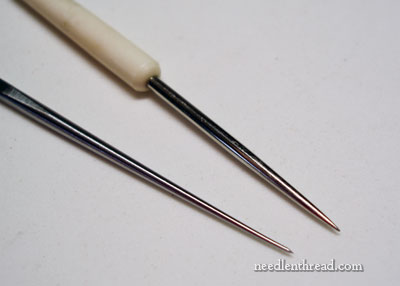
Another tool that can help you control filament silks is a laying tool. A laying tool is used to help place threads neatly on the fabric when you take a stitch, especially when using more than one thread in the needle at a time. Here’s a video on how to use a laying tool, in case you’re unsure of how they work.
If you don’t have a laying tool, they’re available at most fine needlework shops. This is my favorite laying tool.
That being said, I don’t use a laying tool if I’m working with one strand of Soie de Paris – but if you think it will help you, definitely try it!
Rough Skin & Snagging
Perhaps one of the most common complaints about working with filament silk is that it snags on even barely rough skin. When you’re gearing up to work on a project that involves filament silk, it helps to take some extra care of your hands.
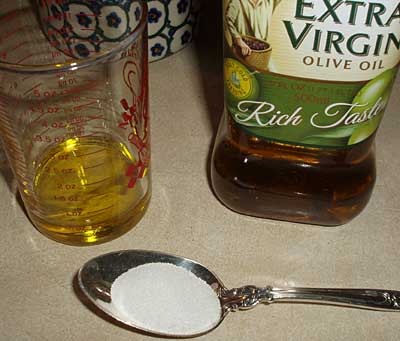
I use a sugar scrub made from olive oil and sugar twice a day when I’m especially concerned about rough skin. It really does work and it makes a huge difference when it comes to minimizing snagging the silk on rough hands.
Attitude
Finally, the last point – attitude.
You know how they say horses can sense fear and tend to be jittery with a fearful, unconfident rider? Well, I’m convinced that the same can be said for silk!
Filament silk is a super duper strong thread. If you treat it like it is the most delicate stuff in the world and you are nervous and jittery about handling it, your stitching experience will undoubtedly be less than pleasant. Don’t fear the thread. Work with it, and make it do what you want it to do. You’re not going to break it (in most normal circumstances).
Your Turn!
Over to you, now! Do you have any tips for working with filament silks, or specifically with Soie de Paris, that can help other stitchers get comfortable with the thread? Feel free to share them below!
I hope these tips help you a little bit if you’re struggling with threads made from filament silk!






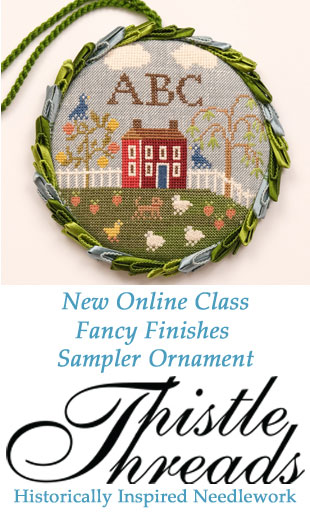
Thanks for those good tips, Mary. I agree with what you say, particularly about being confident with filament silk, and about using a large enough needle for it. And taking care of the unused thread. (I like your box idea.)
I find individual ‘flat’ plies separated and recombined easier to work with than the two-ply strands you have here. Less boingy, especially after being straightened with a damp thumbnail and the pad of my first finger, from head to tail. A quick pull over beeswax works wonders too, but not a heavy coating and again always from the end that will be in the needle to the end that will be in the fabric.
When pulling the needle through, I hold the needle in my first thumb and first finger, but hold the thread in a scissor-grip between the second and third, so that the pull is not on the thread in the needle’s eye – it helps prevent wear, so I can use a slightly longer thread.
I treat rayon in much the same way, but as it is so fragile, I tend to pad the needle’s eye to minimise wear.
My flat threads give a gentler, less glossy result – sheen not shine – so it’s a matter of personal choice. In any case, the one golden rule is to practice and practice, until you are very comfortable with the thread before starting any important project. And to relax and enjoy the process!
Mary, these types of projects are far beyond this busy homeschooling mom. But, I love how you explain things. It is so helpful! I am learning a great deal just by reading your entries. Thank you.
As I read the first lines I kept saying “yes. yes. YES” I’m such a scaredy cat!
What a great article, Mary, with lots of good advice.
I tend to use shorter lengths of thread to reduce the wear on it even though I grip the needle at the eye to pinch the thread. I will often use my laying tool even with a single strand. If the thread has a tendancy to twist and knot, or if it ‘fluffs’ when passing through the fabric, I find keeping in under tention with my laying tool can help prevent this.
I also ‘twizzle’ my needle while stitching to undo any twist I inadvertantly add to the thread while stitching. I wrote about ‘twizzling’ on my blog a while ago.
http://threadsacrosstheweb.blogspot.co.uk/2012/09/do-you-twizzle.html
Dear Mary – looks like the Soie de Paris silk sold in UK comes in skeins rather than spools ( http://www.sewandso.co.uk/ran2060-0.html )- is it the same silk, and how these could be organised safely?
Re Orts jars: I love Yankee candles and never throw away their jars with lovely stoppers after the candle burns out – ideal for storing beads, findings and orts!As they are the same size and shape they also look nice and neat on a shelve in the workroom.
Mary, What sort of silk would you suggest a first timer start with? There seems to be so many that I find it confusing. (let alone to figure what would go with what kind of project) but maybe just for a learning project where would you recommend someone to start?
Hi, Heather – I’d suggest starting with a spun silk. My favorite is Soie d’Alger. It handles much like cotton, so it’s easier to get used to working with it. -MC
Thanks a million!
Just want to say how grateful I am for your daily tips and all the effort it takes to photograph and type them. Thanks so much.
Mary,
Thank you so much! I’m a regular reader, but I don’t comment very often.
This writing on silk filaments had so much information that I can and will use! I’m printing it and including it in my notebook.
I’m definitely going to try the scrub…rough hands are always a problem.
Sally
This was such an enjoyable read. I enjoyed visiting the shop on Etsy for the laying tools. The tip for hands was great, too.
Great information, Mary. The only thing I have to say is that I will often use a Sharp (Embroidery) needle because it is my thought that the thread falls out of the eye less often because it is small and round instead of oblong like the crewel needle.
Hi Mary,
I remember reading about your oil and sugar hand scrub right when I took up stitching again and it’s been next to the sink where I wash my hands ever since. it’s a brilliant solution for keeping your hands smooth – and not just for stitching! That’s the tip that made silk stitching far less daunting for me. Thanks again!
Kathy
Itchy fingers! I way to try it. Off to order soie de Paris RIGHT NOW
I’m having trouble finding it http://www.sewandso.co.uk/ran2060-0.html has it is skeins but I like the bobbin thing and not sure if it’s the same stuff. Where can I buy this in the UK?
Hi, Emma – in Europe, I believe it is sold in skeins. Not 100% certain, but 98%. I’ve heard that it is, anyway. -MC
Dear Emma
Sew & Sew sell Soie de Paris and Soie d’Alger in 5m skeins I use them all the time very efficient the Soie Perlee colour is limited. I hope that helps
Regards Anita Simmance
Thanks! I’ll treat myself to some. I’m working with some kind of synthetic filament bought from a rummage stall. Packaging looks kinda 1950s it goes on very shiny but is none too strong, I have to handle with care. Hoping it’ll be good practice. I habitually hold the thread in the eye like you suggest. I have an indentation in my finger to bear witness!
Hi Mary,
Thanks for the tips. I also hold the thread and needle the same way as you do – right at the eye – and I just started doing way back because it works well. The only thing is that I feel really uncomfortable using a thimble because you can´t grip the needle and thread very well. Also, the silk sometimes snags on the thimbles.
Do you stich with a thimble? I live in Barcelona and there´s a spanish saying that goes ¨quien cose sin dedal, cose poco y cose mal¨ (whoever sews without a thimble, sews little and sews poorly). Every time someone sees me embroidering without a thimble I get ¨the phrase¨.
I´d love to hear your thoughts on this.
Thanks!
Hi, Candice! On, I love love love that phrase – it makes me chuckle! No, I don’t use a thimble – or at least, I use one very, very rarely. I don’t like stitching with them!
Thanks for the smile!
Is Soie de Paris a Z-twist or S-twist thread? Is there a difference in technique when doing satin stitch with Z- and S-twists? If so, do you have a special technique for doing satin stitch with a Z-twist? Thanks!
Hi, Ann – it’s a z-twist. There’s not really a difference when doing satin stitch, since it doesn’t rely on the stitches twisting together to form the stitch. It does make a difference with stem stitch and the like – you can find information on that here: https://needlenthread.wpengine.com/2011/01/s-twist-vs-z-twist-embroidery-threads-stitched.html
Hope that helps!
MC
Hi Mary,
I enjoy every one of your teaching techniques. Thanks for making things so clear. I never know what little jewel of knowledge I can pick up from you. Thanks for all of the jewels.
And here is yet another one….I inherited all my dear Mother’s needle work and sewing threads and flosses. I had come across a thread while working on a project years ago and wanted an area to be shiny and appear sparkly, and the thread was so perfect, but so hard to work with and it wanted to tangle and catch on something every stitch I took. I remember thinking the darn stuff was alive and had a mind of its own because when I laid it down it seem to want to wiggle and crawl. I stressed out over it for some time, I just wanted to scream, but it was so beautiful I couldn’t bear to toss it, so I hid the project away in my UFO’s until I could figure out how to tame it. What appears and is described by your blog got me thinking this is what I may have (or near to it), so I tried your suggestions and WAA-LA! It worked. I’m so thankful to find this out, because now I can resume my beautiful project I had started so long ago. Thanks again for your tutorials.
Love them all,
Tippy
Hi Mary,
I always use a tray to hold my threads and stuff and cover it with a towel and I’m never happy with this. Thanks for letting us know about the box I’ll definetly be changing. Thanks for all your wisdom.
I have also found that an emery board nail file will smooth any roughness on my fingers, therefore preventing snagging the silk thread.
Dear Mary
What can I say what a great informative post. I’ve just used the base of my filament thread spool to secure my thread, thanks for the tip. I love, love (infact I’ve just re-arranged my sewing equipment and put them into a lid) the idea of the lid organiser, and thanks for the information on different spun silk so helpful. Yes I have had problems with filament silks with snagging, thread slipping out of the eye and re-threading numerous times which is really annoying, so thanks for the tip on how to hold the thread when stitching and thanks for the tip on how to care for your hands. So informative.
Regards Anita Simmance
Aloha Mary,
Two things: 1.The people that assemble radar guns, used by police to catch speeders, actually have a device they have to wear to stop any static on their persons while working. Speed- slow stitching -static.lol
2. About silk skeins- I have many (large) and am afraid to use them as I fear a huge tangle up once I open them. Any suggestions as to how to to wind or keep them neat once opened and cut from? Any help from anyone would be so appreciated.
Many thanks,
ji
Mary,
Thank you for another great post! I love the box tip for keeping one’s workspace tidy. I would never have thought to turn the box upside down, and wow! That is a brilliant solution. Super cool! I’ve been trying to stitch with silk recently, and the Soie de Paris that I’ve used in the past definitely falls into “fiddly bits.” Thanks again for all that you share with us. You’re such a good teacher. Have a great day! 😀
I’ve enjoyed stitching with spun silk but avoided filament silk. Your post has inspired me to try it! Do you recommend Soie de Paris for a beginner and can you point me to a vendor? Also, is there a particular ground fabric it would be best to learn on? Thank you for all your help and advice.
Thank you Mary, what a delightfully detailed and practical tutorial in handling what really is a wonderful, if somewhat finicky, fiber. We’re using this material in the Casket of Curiosities course – and I’m going to go tell my classmates to come check out this post…I don’t think I’ve ever seen so many common sense solutions to ALL the common problems presented so well.
Thanks, Elisabeth! I hope the tips come in handy to others, too!
I use acid mantle cream for my hands when working with filament silk. Just the tiniest bit is quite effective. It is usually available from your pharmacist, but is fairly expensive.
The only filament silk I have ever used (I think) is Japanese silk which is untwisted, unless you twist it yourself. I didn’t realize that filament silk was available already twisted. I have stitched with Zwicky in the past and love the sheen, but it has all the negative properties of silk as well. Is it filament silk or floss silk?
You are absolutely correct that silk can smell fear! Some day it just doesn’t like the way I look at it and immediately flies into a tangle!
excellent article.I am now armed with exellent information and feel confident I can work with filament silk threads. thank you so much
A relatively new skin care product I learned about from the wound care center I received treatment from last year is Elta. It is the modern equivalent to A & D ointment. One of the reasons we get dry skin is our dependence on lotions which create a negative feedback loop as opposed to what Elta does–traps your natural moisture. A little bit goes a long way! Really good stuff.
I use brass to keep my silk thread in line. It sounds funny,but I find a brass plate has just the right amount of “cling” to hold my thread without it getting knocked off by a cat jumping to the back of my chair.
I also use a brass chalk holder for playing pool for a ort box. I just tuck it inside the hole and it stays with no issues. It is small enough that I can tuck it into my sewing box out of the way when I am done for the day.
Something I learned to do from Asian embroidery books, is when the silk thread does snag and gets rough, is to rub the thread against the forehead, preferably without any makeup on, and the body oils there will help to smooth the filament threads. Soie de Paris doesn’t snag as often as flat filament silks do, but this tip has really helped when accidents happen. Oddly, it is the Western embroidery fashion to minimally touch the silks at all if possible, which I always have trouble not touching them.
Oh, and it helps to keep those fingernails well groomed and smoothly filed, again to help prevent snags.
Hi Mary,
Just last week did a course with Dianne Magro, a NSW Embroiderers’ Guild tutor, who came to teach at our local group. She showed us how to use threads from duponi silk to embroider wearable art. The fabric we embroidered was also duponi. It was probably the easiest silk thread I’ve ever used. It needed to be kept short, but paid handsomely with shine and strength and slipped through the fabric. I wonder if anyone else has tried the technique?
Catherine: Did you pull your stitching threads from a piece of duponi silk fabric? Janet.
Mary, I really, really appreciated your blog on filament silk. I’ve struggled at times w/this fiber. You’ve given me hope that w/your tips I can finally conquer it. My main problem was the tangling and when I next stitch w/Soie Perle, I think I will feel more relaxed and confident in its handling. Thanks once again, Mary.
Dear Mary
I love silk filament threads and buy mine from China.
They come in a large skein made up of up to 10 shades in smaller skeins. To store them I shake the small skeins out and cut them at the knot then plait them loosely.
I thread them onto a diaper pin and store them in the Peel-Off boxes used by card makers. This way I can see the shades at a glance and they don’t get tangled.
Best wishes
PatsyAnn
Thank you for this clear and wonderful post! I’m embarrassed to admit that after years of working with these spools, I had NO idea about the “snap open / close!” It’s one of those tips that no one but Mary Corbet would consider mentioning. Thank you! I’m humbled (again!) but very happy and grateful! You really do keep stitching so much fun.
Hi Janet, Yes, we used the lovely across-the-width-threads (weft threads?) from duponi silk. You’ll find that what you think is a single thread when you withdraw it isn’t so: there are really two different coloured threads. We separated the “thread” and used both colours in different parts of the design.
A fellow stitcher managed to keep her thread thin but I liked the way the thread could also “spread” to cover a space without showing individual stitches.
Many thanks for your wonderful olive oil and sugar scrub recipe, Mary. I used it this morning after weeding the garden and can face those silk threads this afternoon with confidence!
hi and thank you so much for your generously shared website ! i’m wanting to start doing silk ribbon embroidery and was wondering what website would be best for me to purchase supplies and what would you suggest as a “starter kit”? i’d appreciate any direction. I love your easy to follow tutorials! thank you again
best, lucia
Hi, Lucia – Di van Niekerk’s website is where I go for all silk ribbon info. She sells supplies and kits and books as well. Here’s her website: http://www.dicraft.co.za/blog/ -MC
Good afternoon!
Your site is wonderful, I received an e-mail que you posted monogram embroidered with shadow point. Would Provide for a video with this point as it was presented?
Engracia – Brazil
Such a helpful article!
I have been using untwisted silk filament thread (Soie ovale) for embroidery on a garment. This was a first foray into flat silk embroidery. I’ve found out, naturally, that the embroidery snags as easily after it’s finished as the thread does before it’s used. It’s fragile work, so it’s best to keep it covered up when not being worked on. If you’re putting it on a garment, the garment should be for grand occasions only, and kept stored well wrapped in muslin.
However, the effect is so worth it! The embroidery glows like stained glass, an effect heightened when combined with gold spangles.
Also, I use Soie de Paris all the time, just as plain sewing thread, when handsewing silk garments. Once you’re used to it, it’s hard to go back to cotton: it’s strong and handsome. I wax it well, and to keep the twisties out, occasionally run the thread through the needle’s eye almost to the end, and back, as an antique sewing manual advised (can’t remember which one).
Very best,
Natalie
This is such helpful information, Mary! I adore working with silks, and vastly prefer them to cotton, but it did take a bit of getting used to at first. I wish I had this article ten years ago!
🙂
Heya 🙂 thanks for this. I’m still a newbie at this. Would you use a thread conditioner like Thread Heaven as well?
Hi, Zeb – no, I don’t use a thread conditioner on silk. It changes the look of the thread when you coat it with stuff, whether it’s thread heaven or beeswax…. – MC
Thanks Mary 🙂 I’ve cross stitched all my life, but now want to try different forms of embroidery. Just a tad scary, and I want to get it right! 🙂
My comment/question is over a year old, I realize. I have a project calling for hand embroidering using the backstitch and quilting by hand. The threads used are rayons. Would it work to use the soie de Paris instead of the rayons? Is it strong enough to hold up in a baby quilt? Would it get snagged during use?
Yes, it would work, but if you want to use a fine silk thread on a quilt, I’d go for Soie 100/3 instead. It really depends on how fine the backstitch is supposed to be. Soie de Paris is a very fine thread, and it’s got a loose twist to it. Soie 100/3 is a stronger thread, with a twist, but it’s still quite fine.
Useful tips, thank you, particularly the oil and sugar mixture for my hands; I’ll try it.
Years ago I started a project where I used Japanese silk. To make it more manageable the teacher advised wetting ( just barely damp, not really wet) a small cosmetics sponge and sliding it along the silk every few stitches. I am now ready to finish this UFO but recently read that wetting the silk destroys its strength. What do you think?
Hi Mary,
I realize this is an old post, but wondering if either soie d’alger or soie de paris can be hand washed? Are they colorfast, do I dare get them wet? Will they hold up to washing? Planning on stitching on a linen/cotton hand towel.
They can be hand washed in cool water. Do not apply an iron, or steam, while they are wet. They should be OK. But you should always test first.
Dear Mary,
about getting fingers very soft so there isn‘t any ‚snagging‘ of the (silk)threads: you can use a fine nail-file and rub the skin around your nails with it. It will will give you a very smooth skin, good for handling threads. I have used this method for years, I am a lute player and need very soft skin on my fingers, without any form of grease.
Greetings, Suzanne van Os
Oh, I LOVE the lute! Thank you for the tip! I just saw your online concert scheduled on YouTube. I’ve set an alert – I hope to see it. Thank you, Suzanne!
I work with silk thread quite a bit when I make jewelry. I’m always winding the thread around wire of some sort so I have to handle the thread directly. I found the best way to stop the thread snagging on my hands is to wear the medical gloves you get from the drug store. That has become my go-to for whenever I handle silk thread of any kind.
This is eleven years after your post. Thank you so much for all the wonderful information. I’m currently working on a sampler using 56 ct linen and 100/3 au ver soie. To keep my 20 spools organized I’m using a lipstick organizer. It works brilliantly. I have taken an ultra fine sharpie marker and written the color number on the top edge of the spools for ease of use. I’m also using a size 28 Bohin needle. I have one for each color and store it on the spool at the top where it separates. That way if I have extra thread on the needle it is ready to go.
Sounds like a great organizational idea, Susan! Thanks for the tip!